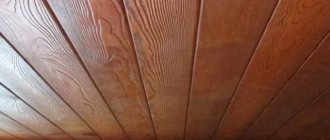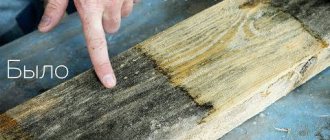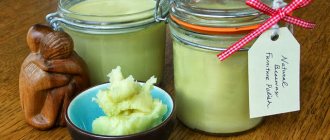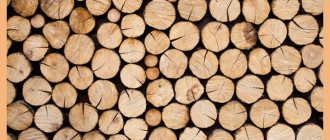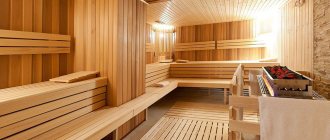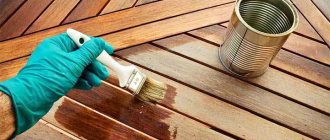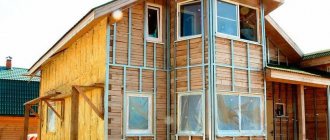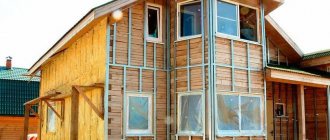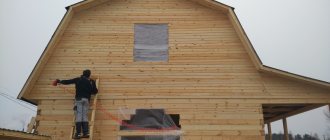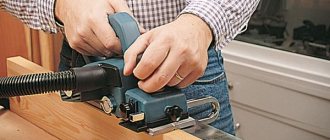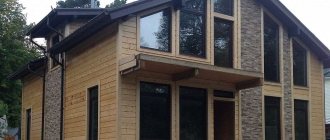A wooden house provides people with the opportunity to enjoy the comfort and coziness of environmentally friendly housing. But at the same time, wood is a living organism, and wooden buildings require more care than brick and concrete structures. Natural phenomena, such as rain, wind, sun, do not have the best effect on wood, which under their influence ages and collapses. Insects and microorganisms, which are very fond of woody structure, where they feel nourished and warm, make their contribution. Treating the outside of a wooden house with special antiseptic agents that protect the tree from the negative effects of natural and biological factors will help prevent destructive processes.
Wood with antiseptic properties
Typically, coniferous trees have such qualities - larch, pine, cedar, spruce.
Treatment of a log bathhouse indoors made from the listed options may not be applicable due to the resinous nature of their structure. It contains phytoncides, which themselves are natural septic tanks, and due to their action, wood is not susceptible to rot, fungus, or bark beetles. Some wood may not even be susceptible to fire.
However, there is also a pitfall in the resin content - bathhouses cannot be built from a large number of them, coniferous trees. At least steam rooms and saunas. Because resin tends to liquefy when heated and flow. It is clear that the walls will become simply inconvenient for bath use.
And the healing effect of the resin is very doubtful - it serves as a natural “plug” for tree wounds and will have the same effect on the lungs. If you use needles for a bath for medicinal purposes, then only as a decoction of needles or their extract, nothing more.
A comparison of resin content is given below:
| Wood | Larch | Pine | Cedar | Spruce |
| Degree of resin content | Very resinous | Moderately resinous | Very resinous | Low resinous |
| Presence of phytoncides | Big | Big | Big | Big |
| Making a bath | Not recommended for steam rooms. Perfect for the first crown | Not recommended for steam rooms | Not recommended for steam rooms | Suitable for the entire log house |
Chemical treatment
However, if the structure for the bathhouse is made of a different type of wood, then it makes sense to think about how to process it in this case. After all, a bathhouse is a structure where wood is not easily in contact with moisture, but also with hot steam, which has more penetrating properties than ordinary dampness.
In this regard, let’s consider what the progressive chemical industry offers today. So, the market offers three types of how to treat a log bathhouse:
- Washable.
- Difficult to wash out.
- Short term.
More details:
- The first option contains metal salts and is recommended for solving the question of how to treat the inside of a log bathhouse. But since the structure of such substances is susceptible to moisture, the decision to use them for washrooms will not be the best solution. Perfect for dressing rooms and rest rooms.
- The second option is well suited for the structure to be processed from the outside. Usually their composition contains oils and synthetics. Having applied them, we can say that treating a log bathhouse with an antiseptic of this type will be reliable protection against external manifestations.
- The third type of antiseptics is suitable for treating log buildings during assembly. They can also cover floor joists, ceilings and other bath structures. The chemicals contain not only components that prevent mold and rot, but also repels bark beetles or other parasites.
Do not forget that all these products are chemicals.
Therefore, their use should be done with caution, since a bathhouse is essentially a room with constant elevated temperature and steam. All containers containing protective compounds must be labeled “for saunas”
Also, when deciding how to treat a log bathhouse, you should take into account that all products should be purchased in specialized stores, and not in dubious retail outlets
All containers containing protective compounds must be marked “for saunas”. Also, when deciding the question of how to treat a log bathhouse, you should take into account that all products should be purchased in specialized stores, and not in dubious retail outlets.
Review of materials
Why do you need wood protection?
Internal processing of a wooden house is included in the list of mandatory measures for finishing the premises. Indeed, the importance of correct selection and application of a protective composition for wood is difficult to overestimate.
There are several reasons for this:
- Firstly, with a long stay in a humid environment, wood fibers swell, and all the parts from which the finishing is made increase in size. As a result, the wall cladding becomes deformed, which can lead to cracks and other defects. To avoid this, the lining and other finishing elements are impregnated or coated with compounds that minimize contact between wood and water.
- Secondly, a humid environment together with high temperature creates an ideal environment for the development of microorganisms, including pathogenic bacteria and fungi. The only way to prevent this is to use antiseptic compounds that have bactericidal and fungicidal effects.
Note! Very often, beginners are interested in whether it is necessary to treat wood with an antiseptic indoors with a normal level of humidity. In principle, this is not necessary, but in any case, antibacterial or antifungal impregnation will not hurt.
- Thirdly, the internal treatment of the walls of a wooden house also performs a design function. Modern compositions for the most part either contain ready-made pigments or allow the introduction of colors, so that if necessary, we can simultaneously provide moisture protection to change the shade of the finish.
Concluding a brief analysis, it should be noted that the price of high-quality products for protecting wood from moisture and microorganisms is quite high. At the same time, their use significantly extends the service life of the finish, so ultimately, treating wooden walls inside the house is completely justified.
Compositions used
To solve the problems we described in the previous section, a variety of compositions are used today. You can analyze their features using the table below:
| Means | Composition and application |
| Antiseptic primers |
|
| Scuba diving |
|
| Varnishes for wood |
|
| Oils |
|
| Waxes |
|
| Paints |
|
| Complex decorative and protective compositions |
|
As you can see, there is a lot to choose from when it comes to treating wooden walls inside the house. However, it is not enough to choose the appropriate option - you also need to apply the composition correctly.
How to properly treat the outside of a log house
For the first time, the log house is treated with antiseptics inside and outside immediately after assembly. Pay special attention to the treatment of the ends and logs in contact with the foundation. Antiseptics are applied in two layers; Primary treatment should not be carried out at temperatures below 10-12 degrees!; The next treatment is done after the log has completely dried and the frame has shrunk. This takes 6-12 months. This finishing involves the final complex and multi-layer processing of the house, which will provide protection for the log for a long time.
It is important to apply antiseptics to a dry and clean wood surface!; Before processing, the logs are sanded to remove the top layer in which fungus and microbes have accumulated during shrinkage. It will remove log defects and level the surface
Sanding wooden walls is a must for an old house, as it is important to completely remove the previous coating;
Processing of a sauna log
The standard method of impregnation with an antiseptic involves working with a brush or spray. Working with a brush is more difficult and takes longer. However, it is indispensable in some cases, for example, when a certain area cannot be properly coated with a sprayer. Every 2-3 hours it is recommended to change the brush to a new one.
Impregnation with a spray gun is considered to be of higher quality and, which is absolutely certain, is carried out much faster.
Advice! It is recommended to treat the wood with impregnation even before the frame is folded with crowns. Only in this way can a thorough treatment of the entire surface be ensured.
In some cases, alternative methods of processing wooden structures are appropriate:
- Method of immersing wood in a container with an antiseptic agent. This approach guarantees impregnation of even the most difficult to reach areas of the structure.
- The diffuse (dry) method of treating with an antiseptic drug involves applying a paste or powder substance to the surface.
Before you begin to impregnate the log house, it must be cleared of all kinds of blockages. A vacuum cleaner is suitable for this purpose. Then the surface must be thoroughly dried.
The compositions are applied in the following sequence:
- means for protection against fungus and moisture;
- impregnation against insect pests;
- fire-fighting agent (fire retardant).
Note! All wooden surfaces need to be treated, not just those that are most exposed to moisture. After finishing surface treatment with antiseptics, it is recommended to apply a gel or primer.
However, we must not forget about the basic rule: the material must be breathable
After finishing surface treatment with antiseptics, it is recommended to apply a gel or primer. However, we must not forget about the basic rule: the material must be breathable.
If everything is done in accordance with the technology, then subsequent impregnations are done no earlier than three years later. Some compositions last up to five years.
Processing the log from the inside
With prolonged and regular exposure to steam and moisture, which the operation of baths implies, the functionality and appearance of wood may suffer. Without the use of special protective equipment, the service life of the log house is reduced. Wood is best protected from harmful effects by special oils for baths and saunas. These are products based on natural ingredients - vegetable fats, wax, lecithin, safe driers, without toxic compounds.
Oils are absorbed into the wood structure, strengthening it and protecting it from steam and water. As a result, the surface does not allow moisture to pass through, repels grease and dirt, and becomes resistant to destruction by detergents. Oils have antiseptic and fungicidal properties, so mold and mildew will not settle on the material. Some brands, for example "Martyanov", additionally include additives against blueing of wood.
The advantages of oil mixtures are obvious:
- Suitable for any type of wood;
- protection even from extreme temperatures;
- improvement of appearance, emphasizing wood grain;
- penetration into hard-to-reach places.
Wood oil for baths and saunas “Martyanov”
It is recommended to treat the inside of the log houses of baths and saunas with oils every 5 years, which will preserve the properties of the wood for many years.
How to treat a wooden house - types and types of compositions
House treatment is the application of special protective and priming compounds that ensure the preservation of the wood for many years. The main goal is to improve performance and extend service life. There are 4 groups of funds:
It should be noted that recently the so-called vapor-permeable protective and decorative products (Tikkurilla, Dulex) have been actively promoted. That is, a layer of paint allows the wood to “breathe” and at the same time protects it from water.
Separately, it is worth highlighting a painting material with a water-repellent effect. It is applied to the ends in a dense layer and forms a durable waterproof film.
For the convenience of customers, manufacturers of paint and varnish products have developed products that can be combined into a separate group - universal primer compositions for treating the outside of a wooden house. These are complex products containing fungicides, fire retardants, saline preservative solutions, etc.: “Fire-bioprotection” from Rogneda JSC, the “XM” series from Yaroslavl antiseptic and many others. Although, according to experts, it is better to use highly targeted formulations.
Protective impregnation options
When choosing how to cover the outside of a log house, you have to take into account several aspects: the protective layer must preserve the natural qualities of the wood so that the house has a pleasant atmosphere and there are no problems with air exchange
The coating for a log house must perform several functions: it must create reliable bioprotection from microbes and pests, protect the wood from fire, in addition, the finishing has an important decorative value
To provide your home with comprehensive protection, you will need to purchase the following types of products:
Antiseptics of domestic or imported origin. These are substances that can be deeply absorbed into wood, increasing its resistance to pathogenic microbes.
There are quite a lot of such products offered today: the most common are “Senezh”, “Belinka”, “Pinotex”, “Neomid 500”, impregnation from Finnish has also proven itself well. Many people trust Finnish antiseptics, since this country has a centuries-old culture of building wooden houses.
- Fire retardants are substances that prevent the spread of fire. They are absorbed into the wood, and when the temperature rises significantly, they come out, forming a film that prevents combustion. Fire retardant treatment must be carried out, since fire is always a very significant threat to a wooden structure.
- The tree must also be protected from street humidity, snow and wind, so you can choose the right product from a wide range of paints and varnishes. Alkyd and acrylic paints for exterior use are now popular; they can be either “dull” or translucent. The second option is chosen by those who appreciate the natural beauty of wood and want to maintain maximum environmental friendliness of the building.
The color can be added directly to the antiseptic impregnation, in which case you can save on purchasing paint. Antiseptics often have a faint green tint: this allows you to better track which areas of the wall have been treated to prevent skips and uneven coverage.
What happens if you don’t treat the log house? Opinions are often expressed that wood can do without impregnation, because old wooden houses in the north last 100 years.
However, we must not forget that only winter forest with dense wood was used for them, and in cold climates the process of decay is slower. In addition, we must not forget about the aesthetic side: the logs will darken very quickly, and blue mold spots will very soon appear on the untreated timber.
When should you treat wood?
When choosing what to cover a log bathhouse with, it is important to correctly determine the processing time. The wood is subjected to the first impregnation during the initial processing, but it does not last long
Its purpose is only to ensure that the wood is delivered intact to the site, and then the owner himself must take care of the future home.
The log house is treated with an antiseptic for the first time immediately after assembly. Wood has natural moisture, and it will take a long time to dry. After assembly, be sure to treat the ends of the log with special means: this will ensure uniform drying along the length of the log, so the end will crack much less.
A layer of antiseptic is applied, after which the log house is left for at least six months for final drying. This is usually done in the fall in order to begin full finishing in the spring.
When the tree dries, a full multi-layer treatment is carried out, which will provide it with comprehensive protection.
According to their purpose, impregnation is usually divided into the following groups:
- Fire retardants. The main purpose of this group of impregnations is to protect wood from fire or other combustion processes. Such impregnations contain certain components, the melting of which begins with increasing temperature, thereby creating a durable film on the surface of the wood. Its essence is to block the access of oxygen to the tree, and without oxygen, as we all know, there will be no fire. Fire-prevention impregnation for wood must be used during the construction and repair of log houses, as the main guarantee of subsequent safety;
- Antiseptics. Antiseptic impregnations protect wood from decomposition and rotting, as well as other types of biological damage. This impregnation contains biocides (special potent poisons), they effectively destroy any pathogenic microorganisms and small insects, preventing them from multiplying and multiplying and at the same time destroying the wood from the inside.
The most common antiseptic impregnations: Aquatex, Kram, Biosept, Tikkurila, Vintol, Biotonex, Senezh;
- Anti-atmospheric. Such impregnations serve to protect wood from various negative environmental influences and precipitation. All compositions of this impregnation protect the structure of the wood from the formation of various cracks, drying out and other deformations. One of the significant disadvantages of such impregnations is that after their treatment, the wood loses its external aesthetic appearance and deteriorates its certain characteristics. When protecting wood from moisture and water, the best option would be complete impregnation - i.e. immersion in the bath.
- Water-repellent special impregnation for wood is a solution that increases the strength of the entire material and its high resistance to water; wax is more often used. These compositions significantly extend the life of wood buildings. This impregnation for wood against moisture and rot is ideal for you. More common and popular in the Russian construction market are solutions such as Tikkurila.
Quite often, water-repellent impregnations for wood contain oxides of certain metals, which protect the material from the destructive effects of ultraviolet radiation, as well as fading and drying out. But the oxides will also give the impregnation a certain color. Depending on the metal used, the color varies from light yellow to burgundy, or blue and violet. Therefore, you can not only protect the wood, but also give it an original and beautiful appearance;
- Combined. Combined impregnations are compositions that protect wood from various factors, for example, from fire and various bacteria, from water and the formation of harmful fungi. In places where humidity is high and the risk of wood contamination is very high, such impregnation is very useful.
Impregnation selection criteria
In order to choose a specific protective solution, consider some nuances. For example, if you choose a water-based impregnation, then you will need additional drying of the wood, which will lead to its deformation.
Use antiseptic impregnations, which are water-based, to treat the linings under the purlins and the purlins themselves; you can also paint partition panels, joists and beams, beams. In this way, you can process elementary lightweight structures that will not deform or bend, and which will not cause much harm or damage.
Oily compounds and oils for wood impregnation have an unpleasant, persistent odor that is quite difficult to erode, and therefore it is better not to use these wood impregnations for internal processing of wooden structures. In addition, all oil solutions ignite very quickly, releasing toxins into the air. Once you have treated the wood with oil, it will become impossible to work, paint or process. Therefore, oil impregnations are only suitable for wooden parts and elements that are located outdoors and are regularly in contact with water.
You should choose an antiseptic impregnation for wood taking into account the specific type of wood, since different types have varying degrees of resistance to various biological destroyers:
- “weak” wood is aspen, linden, alder;
- low-resistant wood - oak, birch and beech sapwood, elm heartwood and maple;
- medium-resistant wood - fir, spruce, larch, cedar sapwood;
- rot-resistant wood - ash, pine, oak heartwood and larch.
Different types of wood absorb certain protective compounds differently, and this should be taken into account when making the final choice of impregnation. Three main groups of wood can be distinguished based on the difficulty of absorbing impregnation:
- difficult - spruce, ash, oak and beech;
- medium - linden, pine core, alder, aspen, maple sapwood;
- light - beech, pine sapwood and birch.
The nuances of do-it-yourself impregnation at home
The price of wood impregnation will depend on its purpose and composition, but you can save a lot and prepare a simple protective impregnation for. In this case, impregnation will be much cheaper than a budget purchase option.
The basis for do-it-yourself impregnation is bitumen.
Impregnation preparation process:
- Pour bitumen into an unused old metal bucket or container.
- Place the bucket on the fire and bring the bitumen to a boil.
- Remove the bucket from the heat and, while stirring, pour in diesel fuel in a thin stream so that the mixture does not have time to thicken even after it has cooled.
In order to prepare a quick-drying impregnation, dilute the bitumen not with diesel fuel, but with gasoline. But in this case, do not heat the composition - the bitumen should completely dissolve in gasoline. After treating wood with this solution, it can be safely painted, coated with various enamels and primed. But under no circumstances use nitro varnishes and paints!
Precautionary measures
Impregnation for a wooden house outside and inside, fire retardant and antiseptic, contain dangerous chemical additives and substances that can... That is why during the processing process, remember your safety measures, and strictly follow the instructions from the manufacturer. Before you buy impregnation, carefully study the information about the degree of toxicity of the composition and its possible use and application inside the house.
Impregnation for wood is a necessary and important protective measure in modern repairs and construction.
. Regardless of the hazardous chemicals contained in the impregnation, it can significantly increase the service life of all buildings and ensure safety from fires and various atmospheric phenomena. Good luck!
A wooden house is an environmentally friendly and safe housing that will never lose popularity. Natural wood does not emit toxic hazardous substances, has a pleasant forest aroma and promotes rapid oxygen exchange. In such a house there is always fresh air, a comfortable environment and a cozy atmosphere.
The logs are easy to lay, which reduces installation time. Due to their light weight, they do not require a deep, expensive foundation. And thanks to the natural beauty and aesthetics of the materials, serious and expensive finishing is not required.
However, wooden houses also have a significant disadvantage. Wood is a natural material that is subject to negative environmental influences. Sun rays, moisture and precipitation, insects lead to the fact that the material gradually darkens and collapses. Mold, cracks and fungus appear, and the structure loses its original appearance. To avoid these problems, it is necessary to treat the log house inside and outside using various means.
The lower crown of the bath
The lower crown of the log house is most susceptible to rotting
The lower crown of the bathhouse is most susceptible to moisture. Therefore, it often rots very quickly. The entire frame is still in excellent condition, but it has to be replaced. What to do?
First, let's determine why the lower crown of the bathhouse rots very quickly. The causes of rotting must be determined in order to take a number of protective measures even when assembling a new log house.
The healthy condition of the lower crown is influenced by the following constructive measures when building a wooden house or bathhouse, which must be done without errors:
- a waterproofing layer of roofing felt on the surface of the concrete foundation in front of the brickwork of the base. This layer of waterproofing prevents moisture from rising from below and absorbing it into the brick material. Wet brick is not the best basis for the lower log of a log house.
- the second waterproofing layer of roofing felt is placed on the upper level of the brickwork of the base. It is the roofing felt that comes into contact with the wood of the lower crown of the log house. This contact must be made correctly.
- vents in a brick base or concrete foundation in order to provide natural ventilation in the underground.
- to prevent rainwater from getting in and stagnating on the roofing felt (see point 2), it is necessary to make a protective flashing. Its design can be different depending on the chosen material. You can simply cover the joint with a flashing board around the perimeter of the log house. You can make a drain from galvanized steel or buy it ready-made and install it so that it covers the joint and, at the same time, protects the basement part of the bathhouse from rain due to a slight offset from the outer edge of the brickwork. You can make a screed with a slope from cement-sand mortar along the upper edge of the base and stick soft tiles along it.
- Treat the lower rims with protective compounds in several layers
The absence of any of the above measures leads to rapid rotting of the casing.
The best way to avoid replacing the lower crowns is to make them from larch. Larch has the ability to harden (turn to stone) even more in the presence of moisture. It is not susceptible to fungi.
If it is not possible to get larch logs and in your region only pine is used for log houses, then you can compromise and find at least a larch board. By placing it under the lower crown, you can solve the problem of replacing the lower crowns in the same way if there were a pair of lower logs made of larch. The option is quite generous in monetary terms.
If you can’t get larch boards, then oak grows everywhere. Oak boards are a good alternative to deciduous boards. In addition, it is easier to replace the board than the lower crown.
Regarding the second point of protective measures: since the waterproofing from the roofing felt layer has a horizontal surface on which the lower log is laid, it is natural that water can stand here in puddles. Therefore, it is necessary to ensure that the surface of the roofing material is not horizontal, but has a slight slope to the outer sides to allow water to flow to the ground.
It's very easy to do:
- cut narrow strips of roofing felt approximately 5 cm wide
- put them 3-4 pieces together
- lay these roofing felt strips in the middle of the width of the plinth (or foundation)
- on top of them, place a layer of roofing felt slightly wider than the width of the plinth. (Usually a meter-wide roll of roofing felt is cut in half, resulting in a width of 500 mm, which is quite enough for waterproofing along the plinth (or foundation).
These additional soft “pads” will give you the following benefits:
- a soft “lining” will close the gaps that have formed between the log and the surface of the plinth due to unevenness of the lower surface of the log itself. In a normal situation, they are either left uncovered and the floor is raised above this joint so that it ends up underground. Or they are plugged with tow, but always from the outside; the joint is sealed with some kind of elastic sealant to prevent the tow from getting wet. This option is not entirely reliable. Better tightness is achieved through a soft “gasket”
- since in the middle it will be higher due to 5 layers of roofing material (4 narrow strips and 1 layer of a wide main strip), then the surface of the waterproofing layer will have a slope for water to drain from its surface.
Even with this design of roofing felt waterproofing, it is necessary to cover the lower crown and the upper part of the base with a galvanized or painted steel drain to prevent any moisture from getting under the lower log (see paragraph 4 of protective measures).
Information on choosing a tree for a log house
When choosing an impregnation or paint composition, it is necessary to take into account the type of wood from which the bathhouse is built. Some breeds do not need additional moisture protection. These species include oak and most conifers. However, each breed has its own characteristics:
- Pine does not like heat and humidity, therefore, it is not suitable for log houses.
- It is better to use spruce in a dressing room, since, despite its excellent thermal insulation properties, this tree is even more afraid of moisture than pine.
- Aspen tolerates moisture well, but gives off a bitter smell.
- Birch loves dryness, and therefore is only suitable for dressing rooms.
- Cedar and larch are not afraid of moisture, but are too resinous.
- Alder is excellent for making logs.
- Oak and ash are used to decorate expensive baths.
The resin of trees suitable for making log houses contains resins that contain phytoncides. These substances are natural antiseptics. Thus, nature itself protects such wood from fungus, rot and insect pests.
However, excessive resinity (as in some species of coniferous trees) cannot be considered a positive quality. The fact is that under the influence of high temperatures, the resin transforms into a liquid state and begins to spread. Of all the coniferous tree species, only spruce best meets the requirements for a steam room.
Note! Whatever wood the bathhouse is made from, it cannot be heated before soaking begins.
Work technology
Preparatory work
If you decide to paint or varnish wooden wall cladding, then the instructions given in this section will help you understand the nuances of the technology.
Work must begin with surface preparation:
- If the boards were previously painted or varnished, then the old coating must be removed. We soften the painted layer with warm water or a stream of hot air from a hair dryer, and then remove it with a spatula.
- We remove the remaining paint and varnish using a sanding machine.
- If we process new wood, then it needs to be sanded all the more. To do this, we successively use several abrasive materials, gradually reducing the grain size - this way we get a perfectly flat surface.
Advice! If there are defects on the sheathing, then before sanding they must be masked by using a small amount of wood putty. After waiting for the putty to dry, we clean the area with sandpaper, and then sand the surface.
- Afterwards, it makes sense to treat all surfaces with a penetrating water-based antiseptic primer.
- Apply the primer in one or two layers, making sure that the wood does not get too wet.
- After the primed surface has dried, the lining inside the house can be painted or varnished.
Application of the composition
Both painting and varnishing can be done with your own hands.
The process itself is not complicated, but there are still a few recommendations that are worth listening to:
- Having decided how to treat the wood inside the house, it is worth purchasing the selected composition with a small margin. The thing is that the shade of paint or tinted varnish may differ in different batches, so it is better to paint everything with one material.
- Before starting work, mix both paint and varnish thoroughly. This is done in order to compensate for the delamination of components that occurred during storage.
- To apply the composition, use a wide flat brush. We will also need a narrow brush on a long curved handle - we will use it to penetrate hard-to-reach places.
- We apply both paint and varnish in several layers. The more layers and the smaller their thickness, the better the result.
- The direction of the strokes should be perpendicular. So, for example, we apply even layers vertically, odd ones horizontally, or vice versa.
- After applying each layer, you need to dry the surface. Drying time depends on the type of composition used, so you need to plan the work individually.
And most importantly, during drying, the fresh layer of finishing should be protected from exposure to drafts and temperature changes, otherwise the coating will quickly begin to crack and peel off.
Preparation for processing
Processing should not be delayed. It must be applied immediately when the log house is ready, even before caulking. If the work is postponed, then the finished log house is covered with a film to protect it from external manifestations - precipitation and other things.
Before treating the exterior of the bath house, you should thoroughly clean it of construction debris. You can even use a vacuum cleaner to do this. Then it is dried and the compositions are applied in this order:
- Impregnation against mold and mildew and for protection against moisture.
- Anti-parasite layer.
- Fire retardant is an important component for wooden buildings.
If everything is done correctly, then subsequent treatments are done no earlier than three years later. Many compositions are good and durable, lasting up to five years.
Wood needs to be processed throughout its existence. Then she will delight her owners for a long time.
Konstantin Shcherbakov
Author of publications on 1Drevo.ru with the topics: Ventilation valves for PVC windows | Round house | Rounded timber | Bathhouse 6 by 4 | Finnish houses | Bathhouse with gazebo | Installation of log house | Pellet boilers | Solid fuel boiler | Electric boiler in the house | Heat pump | Painting laminated timber | Solid timber house | Panel house | Manual felling of a log house | Foundation insulation | House kit made of laminated veneer lumber and others.
In what order to install a log bathhouse
It's no secret that the first crown of the house
or any other building - the most responsible. Since the dimensions of the lumber were known to me in advance, I precisely adjusted the layout of the future bathhouse and the size of the foundation to their length. Having accurately marked the first crown, it was enough in the future to use only a plumb line and a level so that the walls and corners of the bathhouse were vertical.
Log bathhouse. First crown
Before laying the first crown on the surface of the bathhouse foundation, I made waterproofing from two layers of RKP-350 roofing material.
Log bathhouse
, thanks to horizontal insulation, will not be exposed to ground moisture, which can rise through the foundation concrete due to capillary pores.
After the first crown, the rest are arranged. The entire frame made of timber
must be mounted along the crowns so that the lumber in the corners and other junctions is tied to each other.
How to connect beams in corners
To connect the beams in the corners, I decided to use the simplest method, but quite sufficient for strength and heat protection - in a dressing with a root tenon (sometimes it is called a “warm corner”). It’s easier than not to tie the lumber together at all, installing them end-to-end, but then you would have to use staples to tie them together, and the corners of the bathhouse would be blown out.
Log bathhouse. Warm corner
All other methods that were in demand in the past - in a paw, in half a tree, in a cup, I immediately “rejected” as unreasonably complex. With modern means and methods for sealing joints, you can easily avoid unnecessary labor costs.
In order not to mark the configuration of the cutouts in the lumber for each corner separately, I simply made two cardboard templates, according to which I marked the ends. After this, making one or two cuts with a chainsaw and removing excess wood with a hammer and a wide chisel is a matter of a couple of minutes. The direction of the spike on each row must be changed. That is, if in an even row the tenon is on the right and the groove is on the left, in the odd row there should be a groove on the right and a tenon on the left. This bandage firmly holds the crowns together in height, preventing the frame from falling apart.
How to join a beam to a long wall
In some cases, it is necessary to make a T-shaped connection of the timber. This need arises when connecting an internal wall to an external one. I got three such connections for each crown.
It is better to make a T-shaped junction using a method that carpenters call a “dovetail” (in some sources this method is called a “frying pan connection”).
Log bathhouse. Dovetail connection
To do this, the end of the adjacent beam is cut out in a shape reminiscent of this very tail, and a corresponding notch is made in the long beam. After installing the unit, the connection must be wedged. For this, wedges made of dense, dry wood are used.
This type of connection provides sufficient strength and is completely airtight, since there are no through vertical joints.
How to connect crowns to tie a bathhouse frame
The connection of the crowns with each other must be carried out in order to ensure the strength of the structure of the bathhouse frame vertically. In other words, this is necessary so that the crowns do not move relative to each other. Previously, this operation was performed on wooden dowels - rods of round or square cross-section. They were driven into pre-drilled holes, connecting two or three adjacent crowns.
Not wanting to waste time preparing these dowels and drilling large diameter holes, I simply used 200 mm long nails. The nails are hammered very quickly, and if you deepen the head 3-5 cm into the upper beam, the nail will securely connect the two crowns, preventing them from moving.
To finish the nail and immerse it completely into the drilled hole, you need to use a hammer. If you don’t have it on hand, you can use an old, worn-out drill bit from a rotary hammer with a diameter of 10 mm.
Using modern tools
When choosing how to treat the lower crown of a bathhouse or home, it makes sense to consider the advantages of specialized products offered by modern manufacturers. Popular options include:
- Antiseptics for wood. Specialized impregnations penetrate deep into the wood and resist rotting and damage by wood-boring insects. Antiseptic impregnations do not interfere with further treating the wood with a fire retardant, which creates a non-flammable film on the surface, covering the wood with stain and varnish, or painting it.
- Fire-retardant compounds. Universal impregnation simultaneously protects wood from biological damage and fire. Does not change the color of wood, does not impair the gas permeability of the material. Also allows you to paint or varnish the surface of wooden structures.
To treat the lower rims of the bathhouse, the selected product is applied to the structural elements before their installation in order to protect not only the outer surface, but also the joints (locks) in the corners. The protective composition is applied using a spray gun, sponge, roller or brush. Processing is carried out in 2-3 layers, each layer is completely dried. Only after the last layer has dried do they begin to assemble the lower crown of the log house.
When choosing a product, pay attention to the climatic conditions for which it is intended - the composition of the antiseptic varies depending on the operating conditions of the log house. When building in areas with high air humidity, more serious protection is required
Antiseptics and fire-bioprotective compounds of the Senezh, Belika, and Tikkurila brands are popular. It is recommended to purchase wood processing products from reputable manufacturers and check for a certificate to protect yourself from buying a fake.
At all times, builders of wooden houses faced the same problem, the so-called problem of the lower frame of the house and the crown. It is the first crown of a house that almost completely determines its durability, and the choice of wood for its construction or methods of processing it was the secret of a good carpenter. Today, these secrets are no longer such, and in this article we will look at how to choose the right tree for the lower crown of a garden or country house and how to properly process it so that this house can serve for decades.
Main characteristics
Wood is a very durable and unique building material that has a huge number of positive qualities and properties that will be valued at all times. In houses that are built of wood, it is always necessary to maintain natural and more comfortable warmth, and there should always be enough oxygen in the air. The use of special types of wood in construction will allow you to create a special healing atmosphere throughout the house due to microscopic volatile substances and resins, which will have a huge impact on your health.
Despite the masses of positive advantages, wood also has its disadvantages and drawbacks. If you do not take precautions, the wood can deteriorate from the presence of moisture, various fungi and fire, various insects or rodents. And if in ancient times people used various suitable means for protection, today it will be enough just to treat the entire tree with a special impregnation.
You can buy a suitable composition for impregnating wood at any construction hypermarket or market. This is a specific composition that is designed to protect the structure of your tree from the destructive and negative influence of the entire environment, any biological factors and fire. The composition of the impregnation, depending on its components and purpose, can be divided into several types. For example, some impregnations are oil-based or water-based and organic-based.
Rules for applying oil impregnations
- Before applying impregnation, the surface is thoroughly cleaned of dust and dirt and, if necessary, the old coating is removed.
- Then the wood is sanded, dried and the dust and shavings formed as a result of sanding are removed.
- The impregnation is mixed well and applied to the surface with a short-bristled brush.
- Within 7-10 minutes after treatment, remove excess with a soft, lint-free cloth.
- The surfaces are allowed to dry and then polished.
- If necessary, repeat the treatment.
The drying time for each layer ranges from 4 to 24 hours. The exact time required for a particular product to dry is indicated in the instructions. In addition, the drying time is affected by the humidity and temperature of the room, as well as the absorbency of the wood species. In any case, it takes at least a day for the surface to dry completely.
Remember! Wood is only reliably protected from moisture when it no longer absorbs moisture.
Are there natural antiseptics?
Natural compositions for treating log baths are an ideal option. The waste remaining after the oil and copper sulfate will help solve the processing issue. If the logs have been brought to the construction site, but have not yet been assembled into a single product, try using lifting equipment to lower each component into a bath filled with a protective compound.
If this is not possible, give preference to another processing option:
- Dry the log house thoroughly in the fresh air.
- Using a brush, apply copper sulfate to the surface and rub into the deeper layers with sweeping movements. It is better to rub with hands wearing gloves. Copper sulfate is a toxic substance, so be sure to use a respirator.
- When the first layer of vitriol dries, apply another one.
HAVE QUESTIONS? WE WILL HELP!
If you have any questions
about our projects, technologies and capabilities,
call right now on multi-channel numbers:
8 (495) 649-89-90.
